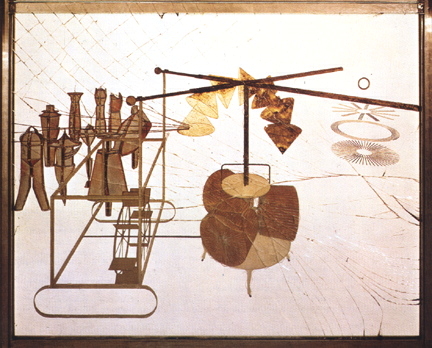The term "bachelor machine" was first used by Marcel Duchamp around 1913 in connection with pieces of work that would later be assembled in the Large Glass of 1915-1923. (Also known as the bride stripped bare by her bachelors, even) For Duchamp, the term refers specifically to the lower portion of the glass, the realm of the bachelors, which contains, among other things, the chocolate grinder, the cemetary for uniforms and liveries -- Priest, Delivery Man, Gendarme, Cuirassier, Policeman, Pallbearer, Footman, Stationmaster and Page Boy -- and the témoins oculistes. The Large glass consists of two distinct realms, the realm of the bride above, and the realm of the bachelors below, both desiring and imagining one another without any possibility of mutual comprehension. (one is here reminded of the real / imaginary distinction and the discussion of cyberspace)
Duchamp's work of this period can be seen as one step in his finely callibrated withdrawal from the prevailing practice of art, and the notion of celibacy introduced through the bachelor machine takes on a specific meaning in that context. In his last paintings, such as the Bride of 1912, Duchamp both elaborated an icongraphy that combined mechanical and visceral forms and began to move away from any procedures that revealed the artist's hand to create "retinal" or "anecdotal" art.
In 1954, Michel Carrouges found a structural similarity between Duchamp's Large Glass and the punitive apparatus described in Franz Kafka's short story "In the Penal Colony" The apparatus consists of a lower part: the "Bed", an upper part: the "Designer", and a part that moves up and down and is called the "Harrow". The condemned man is strapped to the bed and whatever commandment the prisoner has broken is written on his body by the Harrow, which consists of an unspecified number of needles fixed in glass. The prisoner is not told of his sentence. He learns it on his body. This generally takes about six hours of suffering, after which the prisoner, in a moment of transfiguration, reads the inscription through his wounds, and dies in the hours that follow. In Kafka's story, the officer in charge of the punishment, seeing that the system of the colony is breaking down, places himself in the machine and dies as the machine self-destructs.
from Harald Szeeman, Les Machines célibataires
For Carrouges, the similarities between these two machines resides first in the fact that they both operate as closed circuits and second as the action of one zone upon another. In both of these machines a message from the upper zone is inscribed upon the lower one. The fact that one is about sex while the other is about death underscores the importance of the modern myth of the bachelor machine, a sort of new technological version of the mirror of narcissus, in which is played out the interferences of machinism, of terror, of eroticism, and of religion or anti-religion. The myth of the bachelor machine is a kind of double articulation of difference: sexual difference and machinic difference.
For Deleuze and Guattari, the bachelor machine "forms a new alliance between desiring machines and the body without organs to give birth to a new humanity. The subject, which is produced as a mere residuum alongside the desiring machines confuses himself with the bachelor machine, and thus the autoeroticism of the bachelor machine gives birth to the subject. The bachelor machine produces pure intensive qualities."

